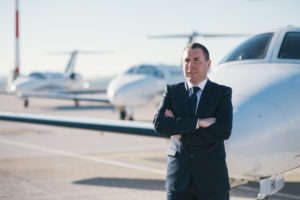Words by Paul Willis
With the growth of online a new breed of entrepreneurs has entered business aviation. Tech-savvy and eager to shake things up, they are disrupting the status quo with business models that leverage digitalization and innovative payment models. They are forcing change on a sector they often regard as old-fashioned and out-of-touch.
Business Airport International caught up with some of the people behind this new generation of startups to pick their brains on the secret of their success, their thoughts on the industry now and where it is headed.
Justin Crabbe, CEO of Jettly
 What’s your business model?
What’s your business model?
It’s similar to other on-demand e-brokers but we strip out the commission and replace it with a flat membership fee, which gives the customer access to our 24 hour booking team, flight support department and a network of aircraft and operators. We’re seeing a lot of customers coming to us from the traditional broker models. Brokers can be like used car salesmen, in that you don’t know how much the dealer is making and you always feel like you’re getting ripped off. We wanted to make it so that the customer doesn’t have to shop around anymore.
What is the biggest barrier to your growth?
The availability of operators in certain countries. In some parts of the world operators don’t work with brokers in the same way they do in North America or in Europe. That’s a hurdle because if a request comes in for an area where we don’t have an operator then we have to position one in and that incurs an additional fee.
What proportion of your business is domestic versus international?
We’re based in Canada and New York, so we regard the North American market as domestic. At this point 70% of our flights are in North America and 30% international. But that’s shifting as we have more rollouts in Europe in particular. It will probably reach 50/50 within the next two years.
How do you stay on top of regulations?
We’re careful to stay within the regulations and our regulatory compliance personnel constantly monitor the US Department of Transportation, Transport Canada and the European and UK regulators, because it’s an ever-changing field in aviation.
Who is your typical on-demand customer?
About 30 to 40% of our clients are high-net-worth families flying for private reasons. Most of the rest are corporate. We have a lot of corporate clients who own larger transatlantic jets but need something smaller and more economical for shorter haul flights. Or because the larger jet is already been used by one team of executives, they need another plane for another team of executives.
How is on-demand disrupting the business aviation market?
Fractional ownership is an antiquated model, similar to how taxis were before Uber. The other major model – the jet card model – is similar, in that you tend to be paying triple the hourly rate of the charter price. In both cases you have to tie up capital, and that’s something I see companies moving away from. They want to keep their capital locked with them and be able to request the flight on-demand with no strings attached.
Adam Twidell, CEO of PrivateFly
 Were you the first on-demand e-broker in private aviation?
Were you the first on-demand e-broker in private aviation?
You can get into a competition about who was the first to do it. What I’d say is that we were the first to think about how people search for private jet information – that was our leading advantage. We took clients all the way through from an enquiry, to quoting, to booking, to paying online. It meant we had a lot of customer acquisition online.
You were bought last year by US multinational Directional Aviation. How has that changed things for you?
Our parent company has a complete vertical integration across private aviation. We continue to compare all the market within a safety-accredited network but at the same time we now have access to the family fleet, so to speak. It’s a bit like Expedia. They compare all the hotel prices in New York but at the same time they might offer a promotion with a particular hotel they are affiliated with. We can do the same thing.
Have you found the business aviation sector to be resistant to change?
If we rewind 10 years no one believed in the internet. That’s how behind the times it was. Today the on-demand market is still being hindered by out-of-date systems in the background. Some airports like Geneva are really good. They have a transparent, streamlined slot-booking system for showcasing when slots are available. But they are still the minority. For example, Mykonos is one of the most popular European destinations in the summer now but acquiring a slot there is hugely complicated. There’s no reason why places like Geneva can’t share their technology with other airports they’re not in competition with. I think representative groups like the European Business Aviation Association (EBAA) could help facilitate this.
What’s your advice to entrepreneurs just starting out?
Talk to as many people as you can and go directly to the big guys because you’ll probably be surprised at how much time these people give you – many are only too happy to help and give back. Then once you’ve listened to everyone trust your gut. If we had listened to everyone, we probably would have never started PrivateFly, but we had a gut feeling that it was going to work and went for it.
What will business aviation look like in 2025?
Just as ten years ago in business aviation there was a split between believers and
non-believers when it came to online, the same split exists today for electric flight. I’m certainly a believer. There are over 200 different companies now with aircraft at a flying stage. They are undoubtedly going to have a big influence.
Rudd Davis, CEO of FlyBlackbird

What’s your business model and how is it disruptive?
We are the only aviation market place in existence that’s focused on general aviation. That means charter operators can use our platform, but more importantly private plane owners can use it too. These private planes typically only get flown one to 2% of the time. The rest of the time they just sit on the tarmac. We match these planes with commercial pilots, who also apply to be on the platform. It’s a way for private owners to earn money by renting their plane out and for pilots to earn more money and flying miles.
More importantly, it gives customers an opportunity to fly wherever they like for a very low price. We’re all about giving access to a completely different customer base, one that until now has been priced out of using charter.
Have you found the business aviation sector to be resistant to change?
It’s very antiquated. General aviation hasn’t seen any real innovation since the 1950s.
Has it been challenging operating in such an environment?
It’s definitely been a challenge. Clay Christianson, the academic who coined the term disruption, used the Ford Model T as a classic example of a disruptive technology. It wasn’t that Ford invented the car, but they invented the assembly line which lead to mass adoption, he said.
So, we’re not inventing this mode of transport, we’re just making what has traditionally been aspirational and out of reach accessible to the common person. A lot of people see us coming along and they don’t appreciate what we’re doing because we change their margin equation. Until now the charter industry has enjoyed an incredibly inefficient marketplace with no transparency about pricing and about who’s good and who’s bad.
How have you dealt with this resistance?
What inevitably happens is that any time anyone vehemently disagrees with us, we invite them in and they walk away being supporters. In part because our model is going to help solve the problem of the pilot shortage in private aviation, which is on the horizon. The regional airlines used to be the feeder system for pilots to get enough flying hours to get their Airline Transport Pilot (ATP) – the license needed to pilot scheduled commercial flights in the US. But the regional airlines have mostly gone away. Now if you want to get your ATP you have to subsidise it yourself. What we’re doing is providing a way for these pilots to get the hours they need for the ATP and earn money along the way. Once we lay out this context for people, they generally walk away happy.
What will business aviation look like in 2025?
We’re really excited to embrace electric fixed-wing planes because in the next five years for the 50 to 500 mile journey, small electric aircraft will be cheaper than driving. Whenever you introduce something like that into the transportation eco-system you create behavior change.
Charles Denault, CEO of SimpleCharters
 What’s your business model?
What’s your business model?
SimpleCharters lets anyone book private jets in one click. Our technology leverages hundreds of privately-operated aircraft fleets around the world, providing customers with a unified and instant booking experience with no membership fees or up front costs.
What is the single biggest factor in your success so far?
The key has been to provide a consistent customer experience with no surprises. The private aviation space is so saturated with misleading models, our growth is very much attributed to our simple, clean user experience which extends from the customer’s first interaction online, through to boarding their aircraft.
Who is your typical on-demand customer?
Most of our customers are actually experienced, regular users of private aviation. They typically own or have fractional ownership of an aircraft or have a jet card and use SimpleCharters as a supplement.
How is on-demand disrupting the business aviation market?
One of our largest, fastest growing segments is in the turboprop category. Customers, especially fractional owners, are realizing that their average flight is less than two hours and are looking for a more efficient way to travel. Instead of spending two very expensive hours in a large cabin jet, the trip can be done in roughly the same amount of time in a light jet or turboprop, often arriving closer to their destination for a fraction of the cost.
Over time, this will move a large number of flights to the smaller, less congested airports. We’re working on some incredible features and tools to pull airports and FBOs into the mix to showcase their unique value propositions to the customer. They’re a pivotal part of the market but seem to have been neglected over the years.
Have you found the business aviation sector to be resistant to change?
The business aviation sector is incredibly archaic. In a world where nearly every other market has been digitized, it’s eye opening to see behind the scenes at the major players. Broadly speaking, every company still relies on a manual process for all of their bookings – even if it has a nice online interface.
What will business aviation look like in 2025?
Dramatically different than it is today. Aggregation and digitization will all but eliminate jet cards and similar membership models. If access is ubiquitous with no barriers to entry, there’s simply no need to pay annual dues or buy 25 hour blocks to use the same aircraft that our customers are already flying.
Bernhard Fragner, CEO of GlobeAir
 What’s your business model?
What’s your business model?
Because we operate our own fleet, we are in a unique position to be able to offer customers fast, short notice and all-round package booking. We have a fleet of 20 Cessna Citation Mustang jets whose position we track in real-time, and we provide this data to the customer. If one of the jets is already at the requested departure airport, GlobeAir can assure a takeoff within one hour.
Do you think the business aviation sector is old-fashioned?
I don’t think business aviation is old-fashioned. It’s actually a sector that is always looking to invest in new technologies to support every department, from pilots to customer care, maintenance to accounting. Unfortunately, a lot of young pilots have an incorrect perception about business aviation. The latest generation of pilots are afraid they’re going to walk into a 1970s style business jet company, where the only benefit is to build flying hours. Nowadays everything has changed, and we can offer pilots a very good career similar to what they would find at a commercial airline company. Overcoming this stereotype is a big barrier to recruiting the right pilots into the industry.
How has business aviation changed in recent years?
Customers today are more interested in using the service as a necessity rather than seeking exclusivity. In the past luxury was a big factor but this is becoming much less important. What’s more important to customers now is flexibility, availability and time. Being able to depart and land at almost any airport at any time and ahead of schedule – these are the qualities that are most valued.
What will business aviation look like in 2025?
More people will be gaining access to business aviation as its costs come down. Technology is moving fast and electric engines will play a big role. Customers will be able to order a business jet just by talking to a virtual assistant. Meanwhile, a new generation of supersonic jets will allow you to fly to the other side of the world within a few hours.





